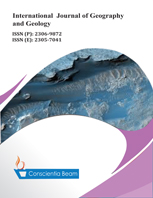Demarcation of Groundwater Potential Zones Using Geospatial Technology in Edappadi Block, Salem District, Tamil Nadu, India
DOI:
https://doi.org/10.18488/journal.10.2021.102.36.49Abstract
Groundwater is one of the world's most valuable resources, which contributes 85% of drinking water supplies. It is imperative to explore ground-water zone for the utilization to the people. Edappadi block in Salem District, Tamil Nadu, is rocky terrain largely depends on groundwater for drinking and irrigation. One of the most useful tools for locating ground water potential zones is remote sensing and geographic information system (GIS). Different types of thematic maps, such as lithology, geomorphology, drainage density, slope, lineament, and land use/land cover, can be easily created by visual interpretation of IRS-1C, LISS-III data and maps are prepared using GIS. The water potential zones are determined using a rank and weightage approach. In order to demarcate the water potential zones, the vector overlay method is used. Lithology is given more weight than geomorphology, followed by lineament density, lineament frequency, lineament intersection, slope and land use/land cover. Based on the overall results, the potential zone of groundwater in the research region is divided into five groups: Excellent, Very Good, Good, Moderate, and Poor.

